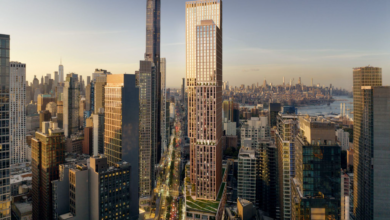City Council Advances Midtown South Rezoning

The Midtown South rezoning was a test. What does this mean for future upzonings?
The City Council Land Use Committee and Subcommittee on Zoning and Franchises on Wednesday advanced the 42-block rezoning, but trimmed 165 units from the original plan.
The changes that reduced the projected unit count were not as extensive as some had sought. The Council nodded to a request to reduce residential density in the southeast portion of the rezoning area, doing so within just four blocks. It also removed a high-density residential district from the northwestern portion, leaving it as a light manufacturing zone.
The carveouts, as explained by the Council members, were in response to concerns raised by the garment-related businesses (manufacturers and wholesalers) that they would be pushed out as owners opted to demolish their buildings to take advantage of the upzoning.
The result: Instead of an estimated 9,700 units, the rezoning is expected to net 9,500 over the next decade.
The changes were mostly surgical and didn’t make a huge dent in the projected unit count. It is important to note that these projections are just that: projections. What ultimately gets built will depend on a number of factors; things like developer whim cannot be quantified in a review intended to estimate how many apartments are likely to be built.
The changes to the rezoning reduced the projected housing production by just 2 percent. Still, I wonder if this is the kind of change that would trigger action by an appeals board. The Charter Revision Commission has proposed creating one that could overrule land use actions by the City Council, including modifications to rezonings. It’s a small reduction in housing, but a board might find that any reduction (within the city’s power) is unacceptable.
The rezoning is the first to map two new residential districts, R11 and R12, that were created as part of the City of Yes for Housing Opportunity. The designations allow residential floor area ratios of 15 and 18, respectively.
Back in 2023, when the city was still pushing the state to lift its residential FAR cap, land use hawks speculated on what areas of the city would likely be upzoned if the state were to act. At the time, one attorney pointed to Long Island City, Midtown, Downtown Brooklyn and Lower Manhattan as “low-hanging fruit.” The administration has opted not to pluck the first, capping residential FAR in the Long Island City rezoning at 12. As I noted earlier this week, if the City Council had failed to map those districts at all in Midtown South, chances of doing so elsewhere would be killed.
The fact that the Council kept most of those districts intact in Midtown South doesn’t necessarily open the floodgates. And the modifications may mean that rezonings elsewhere will also include carveouts. But approval of this first rezoning might give more momentum to proposals in other high-density areas.
What we’re thinking about: Where should the city try to map R11 and R12 districts next? Send a note to kathryn@therealdeal.com.
A thing we’ve learned: Former HFZ Capital Group exec Nir Meir was a subscriber to this newsletter. Court filings included an email to Meir’s HFZ email with a September 2019 edition of The Daily Dirt attached. Meir, who is accused of orchestrating an $86 million fraud scheme, was released from Rikers in June after posting bail. Thank you to TRD’s Keith Larsen for passing the newsletter tidbit along!
Elsewhere in New York…
— The Campaign Finance Board again denied Mayor Eric Adams’ bid for matching funds, the City reports. The board cited Adams’ now-dismissed indictment and his failure to adequately respond to questions about hundreds of suspicious donations as reasons to deny the public funding.
— NYC has opened the country’s first city-funded homeless shelter for transgender and gender non-conforming people, according to Gothamist. The Long Island City facility will have 150 beds and cost $65 million to operate through 2030.
— City Hall officials greenlit a plan for a 34th Street busway after speculation that the project had been axed, amNY reports. The project got the go-ahead as part of the Midtown South rezoning. The busway would improve bus speeds by up to 15% and support the residents of the nearly 10,000 new apartments that will result from the rezoning. — Quinn Waller
Closing Time
Residential: The top residential deal recorded Wednesday was $20 million for a 6,163-square-foot townhouse at 230 West 11th Street in Greenwich Village. The Eklund-Gomes Team at Douglas Elliman had the listing. The property last sold for $20 million in 2023.
Commercial: The top commercial deal recorded was $86 million for a 34,3701-square-foot office building at 141 Willoughby Street in Downtown Brooklyn. The transaction included 383 Gold Street. Savanna Funds sold the properties to Capstone Equities. The Real Deal reported on Savanna’s foreclosure in June.
New to the Market: The highest price for a residential property hitting the market was $18 million for a 4,500-square-foot townhouse at 20 Charles Street in Greenwich Village. Adam Modlin and Andrew Nierenberg of The Modlin Group have the listing.
Breaking Ground: The largest new building project filed was for a 269,062-square-foot, 282-unit project at 413 East 120th Street in East Harlem. Paul Castrucci filed the permit on behalf of Rona Reodica at the Housing Preservation & Development organization.
— Matthew Elo

